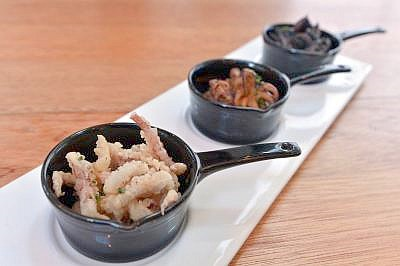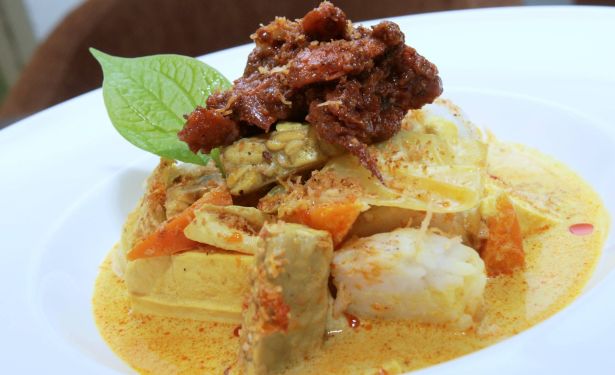MediTeca,
Lot 163, Fraser Place,
Jalan Perak,
Kuala Lumpur.
Tel: 03- 2181 2426
Business hours: Mon – Sat,
11.00am till late night
TAPAS often seem like the free-spirited Bohemian cousin of the traditional meal; instead of the banality of a course-by-course, one-dish-per-person structure, you indulge in small portions of a variety of things, eaten in no particular order, and often, accompanied by copious amounts of your favourite tipple (sangria, anyone?).
Creating a tapas meal, then, comes with its own set of challenges – not only do all the dishes have to complement each other, they also need to be distinctive enough to make an impression.
The newest kid on the tapas block in Kuala Lumpur, MediTeca, gets this balance down pat with its array of delights. While there are plenty of mains to choose from, it is the southern Mediterranean restaurant’s shared dishes that are its pride and joy.
While the menu is divided into tapas, entrées, mains and so on, in keeping with the theme of the restaurant, most dishes can easily be shared.
Here, traditional Spanish and Italian dishes retain their rustic charm, but restaurant manager Alex Schulz points out that they are given a contemporary spin. He goes on to explain that they also hope to educate people on new varieties of wine by the glass, particularly with their wine list that sorts them by flavour profile (instead of, say, region or wine type).
We kicked things off with shots of the palate-tickling Chupito de Gapacho, a traditional tomato gazpacho served with a drop of basil emulsion. Cool and tangy-sweet, with the basil-added richness, the soup was a refreshing starter that got our appetites going. Which was good, because the food that followed was a veritable riot of flavours to be savoured.
Of the tapas dishes, the clear winner was the Cazuelita de Estofado de Ternera, a mini casserole of stewed and sliced beef cheek with spheres of deep fried potato. Succulent and tender, the beef was perfectly cooked, with delicate yet tantalising flavour. In comparison, the Gambas al Ajillo, prawns sauteed in olive oil, garlic and paprika, were quite delicious, but not as memorable.
Meanwhile, the Triologia de Pulpo, where baby octopus is prepared in three ways – deep fried, braised with squid ink and garlic, and sautéed in salsa brava sauce – was a hit-and-miss. The contrast in taste of the three types was interesting, but the texture of the octopus was rather rubbery, detracting from the overall dish. A chilled glass of Australian dry rosé, says Schulz, would complement these tapas dishes perfectly.
Next came the entradas, or entrées, which pair well with a New Zealand pinot noir or a dry German riesling.
The Huevos Rotos, where a fried egg is placed atop a stack of onion marmalade, confit mushrooms and fried potato cubes, then dressed with a truffle emulsion and draped with a slice of Jamon de Vaca (beef ham), should satisfy any fan of breakfast food with its delicious heartiness. The truffle emulsion added an unexpected elegance to the homey ensemble.
Equally surprising in its own way was the Anchoas con Escalibada, where anchovies are accompanied by roasted red and yellow capsicum and roasted eggplant, then dressed with a parmesan cream sauce and olive oil. The explosion of flavours while having a mouthful of this – sweet, salty, earthy and creamy all at once – was heavenly.
Of the mains, the Arroz Negro (squid ink risotto with seared scallop and aioli) was almost certainly my personal favourite of the whole meal. A near-perfect risotto, it is actually cooked like a paella, giving just the right texture to show off the melding of flavours between the squid ink and aioli.
The Carre de Cordero, on the other hand, was rack of lamb served medium rare with a cauliflower purée and pistachio sand – a familiar offering made special by expert cooking, letting the lamb’s juicy flavour speak for itself with just a touch of help from the delicate purée. A glass of Spanish Tempranillo or an Italian Barbera, says Schulz, will be perfect with these two dishes.
We ended the meal with a Crema Catalana, Spain’s version of the crème brûlée flavoured with cinnamon and citrus. While cooked perfectly – the caramelised crust was just crunchy enough, while the custard was silky smooth – there was hardly a hint of either cinnamon or citrus, a little bit more of which would have given this dessert just the kick it needed. To match its subtle sweetness, a sweet Spanish sherry, like an oloroso, is recommended.







